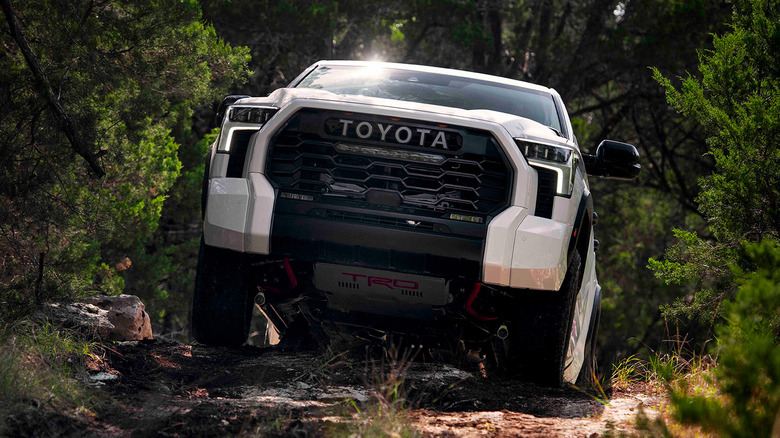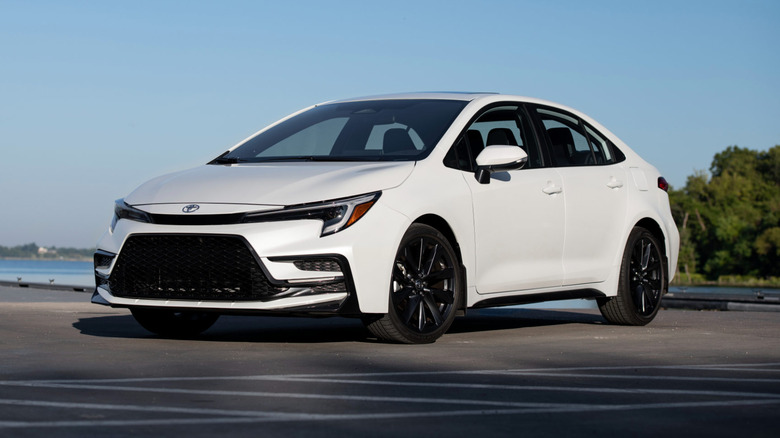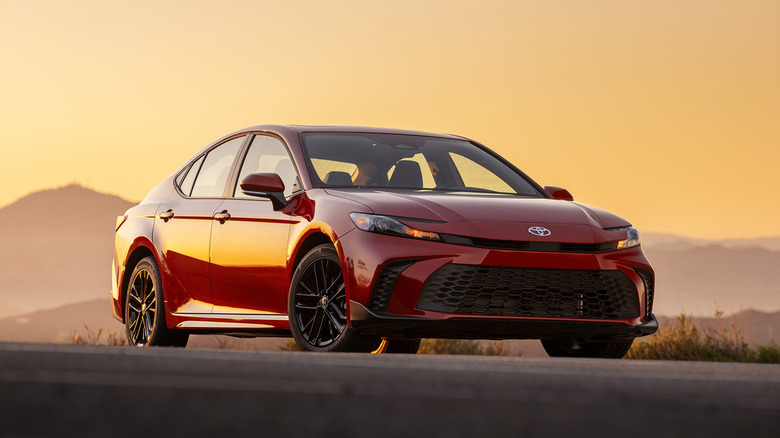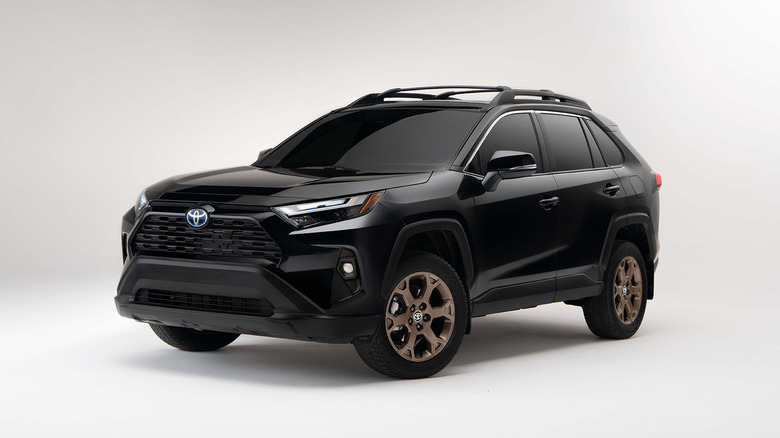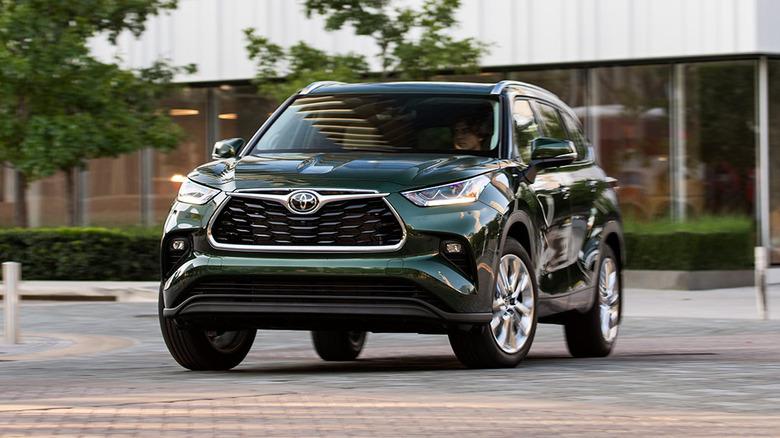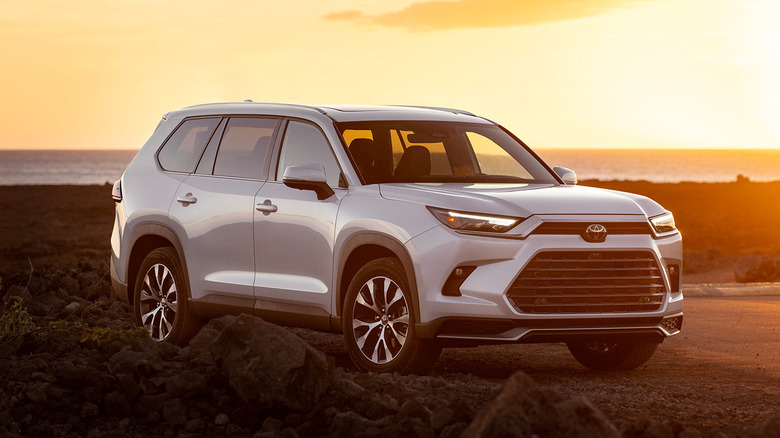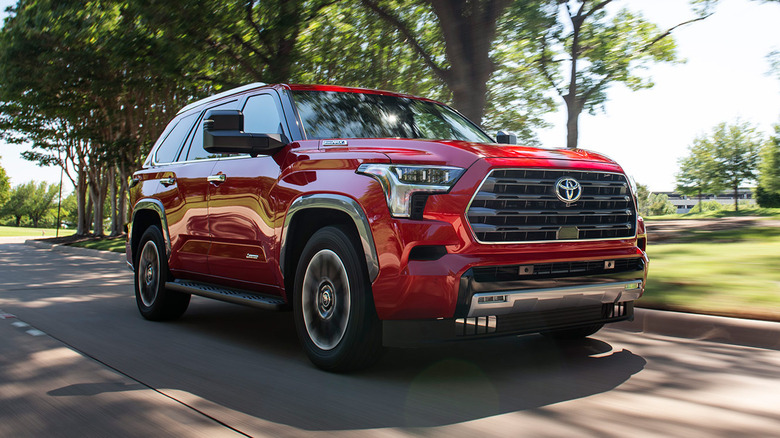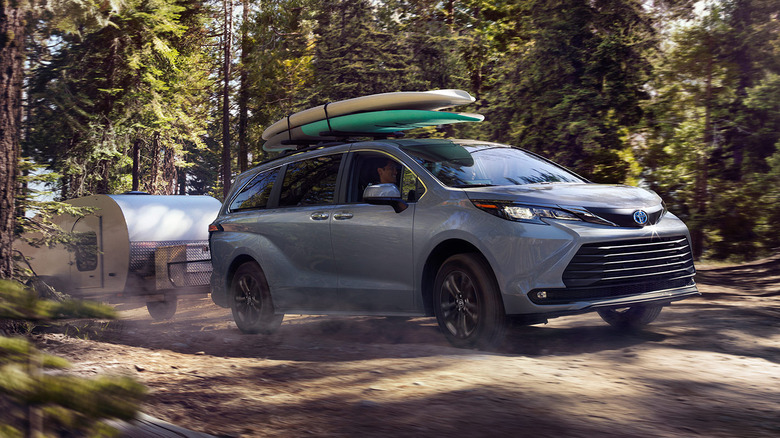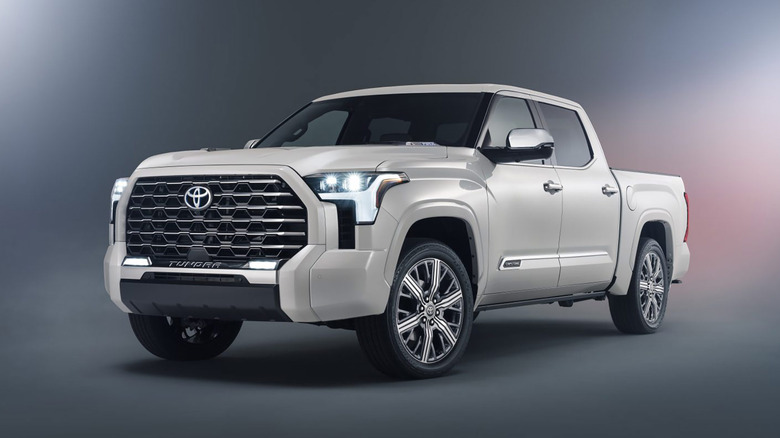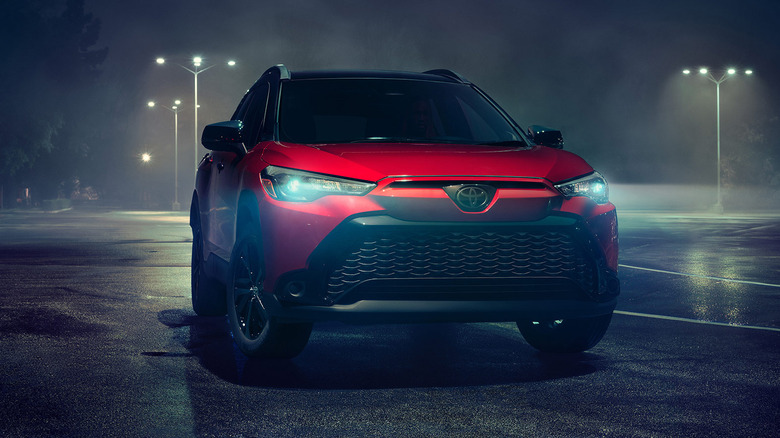Every Toyota Model Made In The U.S.A
Today, Toyota is the undisputed No1 largest automaker in the world, having sold an unprecedented 11.2 million vehicles in 2023, but the Japanese brand had humble beginnings. Its founder, Sakichi Toyoda, established it as an automatic loom manufacturer. However, his son, Kiichiro Toyoda, used the success of the "Toyoda Spinning and Weaving Company" to establish an automaker. Since then, Toyota Motor Company has transformed into a manufacturing behemoth, changing the automotive landscape for good.
A crucial step in the company's rise to prominence has been conquering the U.S. market. Although others saw it as an insurmountable task, Toyota had a plan. From developing market-specific vehicles that would suit the American customer to opening manufacturing facilities in the U.S. and Canada, the Japanese company had everything it needed to succeed. In fact, its Toyota Motor North America subsidiary is a huge entity in its own right, with its own R&D and design centers that develop vehicles suitable for the American and Canadian markets.
Today, Toyota has ten manufacturing facilities in the U.S., of which four build complete vehicles while the others produce engines, transmissions, catalytic converters, castings, and other automotive parts. The "Made in U.S.A." actuality has helped these models become very popular among American buyers, with Toyota sitting in second place, only slightly behind Ford. But which models from the Japanese manufacturer are actually American-made? This article will answer that question and give you detailed information about each of those vehicles. From economy cars to full-size trucks, here is every Toyota model made in the U.S.A.
Toyota Corolla
The latest 12th-gen Corolla sedan is produced at the Toyota Motor Manufacturing, Mississippi, Inc. (TMMMS) plant. It's one of the best Corolla generations, available in pure gas or hybrid form. There is even the GR (Gazoo Racing) version with a 1.6-liter turbocharged three-cylinder, producing 300 hp and 273 lb-ft of torque. The GR Corolla, along with the 2.0-liter hatchback and Corolla hybrid, are built in Japan.
However, the sedan, which is by far the most popular body style in the U.S., is built in North America. For the 2025 MY, the Corolla sedan is offered with two powertrain options. The base 2.0-liter naturally-aspirated four-cylinder engine produces 169 hp @6,600 rpm and 151 lb-ft of torque @4,400 rpm, paired exclusively to a CVT. However, the transmission is a Direct Shift-CVT, meaning it utilizes a launch gear to accelerate more quickly off the line. Then, the transmission shifts from the mechanical gearset to the CVT, which allows for better efficiency.
Although the transmission works better than previous iterations, it still pushes the engine into coarse territory when you press hard on the gas pedal. Other than that, though, it's a fairly refined family vehicle when driven normally. We also liked the Corolla Sedan 2.0 for the space it offers, excellent safety tech, and sporty styling. Meanwhile, the Japanese-made Corolla hybrid offers far better efficiency (48 mpg vs. 35 mpg combined), though it also starts at a higher price ($24,900 vs. $22,050).
Toyota Camry
The Camry was Toyota's most successful passenger car in the U.S. before crossovers/SUVs rose to fame and the RAV4 took the bestseller crown. But unlike most of its American rivals, who axed their mid-size sedans due to slowing sales, the Camry is still going strong. All trims of Toyota's sedan sold in the U.S.A. are also built in the country, particularly at the Toyota Motor Manufacturing, Kentucky, Inc. (TMMK) plant.
For the 2024 MY, this included two gas models — a 2.5-liter four-cylinder, a 3.5-liter V6, and one 2.5-liter hybrid. The V6 has been the highlight in the lineup, offering sound and performance that differentiated Toyota's sedan from its rivals, even when compared to some German four-cylinder turbocharged machines.
Unfortunately, Toyota axed both gas versions for the 2025 MY, and the all-new Camry is only offered as a 225 hp (232 hp with AWD) 2.5-liter four-cylinder hybrid. Thus, the revised model lost its connection to the enthusiast crowd. Still, with up to 51 mpg combined for the Camry LE FWD, it's a seriously economical vehicle that puts most other mid-size sedans to shame.
Still, the thing that surprised us the most was the 2025 Toyota Camry's dynamic capabilities. The sedan has retained the comfortable ride Toyota customers expect but is now also very capable in the corners. Surprisingly so, in fact. The fifth-gen hybrid system is also more refined, with much less groaning when it is pushed hard. The higher-quality, better-equipped cabin is the finishing touch that makes the latest U.S.A-made Camry a very appealing mid-size sedan.
Toyota RAV4 Hybrid
The regular RAV4 Hybrid is made in the same Toyota Motor Manufacturing, Kentucky, Inc. (TMMK) factory as the 2025 Camry Hybrid. Meanwhile, the regular model with the 2.5-liter gas engine comes from either Toyota Motor Manufacturing Canada Inc. (TMMC) in Woodstock, Ontario, or the Takaoka plant in Japan. Some RAV4 Hybrid models are also manufactured in Canada, though. Finally, the top-of-the-line RAV4 Prime plug-in hybrid comes only from Japan.
Still, the regular hybrid has risen significantly in popularity recently, as it had its best year in 2023. Thus, it wouldn't be surprising if Toyota axed the gas-only RAV4 for the next generation and instead doubled down on its electrification efforts with a hybrid/plug-in hybrid combo. That wouldn't be a big loss, as the entry-level 2.5-liter engine isn't particularly exciting, producing 203 hp @6,600 rpm and 184 lb-ft of torque @5,000 rpm.
In fact, the RAV4 Hybrid is more powerful, delivering 219 hp and 184 lb-ft of torque to all four wheels (electric motor on the rear axle) while delivering far better fuel economy at 41 mph combined versus 30 mpg for the gas model. It is quicker, too, finishing the 0-60 dash in 7.3 seconds, compared to 8.0 seconds for the gas-only model. Hence, the 2024 Toyota RAV4 is one of the smartest and most affordable compact SUVs you can buy, despite not stirring the soul like some newer alternatives in the category.
Toyota Highlander
The Highlander has, for a long time, been the Toyota crossover/SUV for those who want more space than the RAV4. With three seating rows on offer, it's more practical, too, making it a darling among people with large families. The latest generation can be economical, too, courtesy of the fuel-efficient Highlander Hybrid trim that we measured at 29 mpg in a real-life scenario.
The hybrid powertrain is no slouch, either, producing 243 hp combined. Like most Toyota hybrids, the Highlander Hybrid is paired to a CVT, which can lead to a drone when you push the pedal to the metal. On a more uplifting note, the Highlander Hybrid is available with AWD, with an electric motor powering the rear axle.
Still, for those who want a bit more oomph, there is a 2.4-liter four-cylinder turbo available. This engine recently replaced the V6, producing 265 hp and a relatively high 310 lb-ft of torque. Unlike the hybrid, it pairs with an eight-speed automatic and, optionally, with a mechanical AWD. Even so, it's similarly quick to 60 mph, reaching there in 7.2 seconds, compared to 7.3 seconds for the hybrid. Therefore, the Highlander Hybrid would be a better choice for most people, despite costing a bit more.
Both the gas and hybrid versions of the Highlander three-row crossover are produced at the Toyota Motor Manufacturing, Indiana, Inc. (TMMI) plant, alongside the Sienna minivan and larger Grand Highlander crossover/SUV.
Toyota Grand Highlander
Before the Grand Highlander arrived on the scene in 2023, Toyota customers who wanted more space than the regular Highlander offered had to go for the body-on-frame Sequoia. However, the Grand Highlander gives the Japanese manufacturer a more road-focused, unibody crossover/SUV made at the Toyota Motor Manufacturing, Indiana, Inc. (TMMI) factory. Based on the TNGA-K platform, the Grand Highlander promises better road manners than the Sequoia and much more space than the regular Highlander.
In fact, when we tested Toyota's latest three-row SUV, we found that it can sit adults in all seating rows and swallow quite a lot of cargo in its 20 cu-ft trunk – with all seats up! Overall, it's the largest and most practical three-row unibody SUV available, particularly in the third row. The interior is full of useful add-ons, too. Notable ones include 7 USB-C ports and 13 big cupholders, smartphone/tablet storage spaces, and a configurable center console that can fit a whole tablet.
Still, although the interior is hugely practical, the star of the show is the brand-new Hybrid Max powertrain. Consisting of a 2.4-liter turbocharged engine, an electric motor, and a six-speed automatic transmission, this electrified engine can push the large Grand Highlander to 60 mph in just 6.3 seconds and tow a 5,000-lb trailer. It's also rated at 27 mpg, which is impressive, as it is a large and powerful three-row SUV with standard AWD. The other two powertrain options are similar to the regular Highlander -– a 245-hp Hybrid with CVT and a 265-hp 2.4-liter turbocharged four-cylinder.
Toyota Sequoia
The Sequoia is Toyota's largest full-size three-row SUV, utilizing the company's body-on-frame platform, shared with the Lexus LX600, GX550, and Land Cruiser. It also features Load-Leveling Rear Height Control Air Suspension and Adaptive Variable Suspension (AVS), which, along with the tough construction, give it an exceptional towing capacity of up to 9,000 lbs, a 22% increase over the previous generation. The Sequoia is also an American-built SUV produced at Toyota Motor Manufacturing, Texas (TMMTX). No wonder, then, that it won the 2022 SUV of Texas award.
Still, the real gem hides under the bonnet. For the first time in a Sequoia, there is a hybrid option: the i-FORCE MAX. Consisting of a 3.5-liter twin-turbo V6, a 10-speed automatic transmission, and a 48-hp electric motor/generator sandwiched between them, this hybrid powerhouse is capable of producing 437 hp and a massive 583 lb-ft of torque. The i-FORCE MAX is the only powertrain on offer, available with either a 4X4 or 4X2 drivetrain. With the 4X4 drivetrain, the Sequoia can reach 60 mph in just 5.6 seconds, which is an outstanding figure considering the 20 mpg combined rating (22 mph on the 4X2 model).
Thanks to the body-on-frame platform, the Sequoia is also an excellent off-roader. That is particularly true for the Sequoia TRD Pro, which impressed us when we drove it last year and which comes equipped with a locking rear differential, 2.5-inch FOX internal bypass coil-overs, and rear remote reservoir shocks.
Toyota Sienna
Three-row crossovers and SUVs are practical, but if you want maximum space and practicality, minivans still reign supreme. Unfortunately, there are not many to choose from today, but on the bright side, the Toyota Sienna is a well-sorted-out minivan with legitimately useful practicality features. There are handy storage areas throughout the cabin, a vacuum cleaner, and even a refrigerator in higher trims. The cabin is spacious, too, though the captain chairs in the middle row (standard on most trims) can't be removed.
The Sienna might not set your world on fire, as it's only available with a 245-hp hybrid powertrain that allows a 0-60 mph sprint of a leisurely 7.9 seconds. In a more optimistic light, you'll visit gas stations less often courtesy of the excellent 36 mpg combined rating. Toyota's minivan is also American-made at the Toyota Motor Manufacturing, Texas (TMMTX) plant in San Antonio.
For those craving some of that SUV goodness, for the 2024 MY, Toyota started offering the Sienna Woodland Edition. This model comes standard with Electronic On-Demand All-Wheel Drive, meaning there is an additional electric motor in the back. Despite being powered by a Toyota hybrid with an e-CVT, the Woodland Edition can also tow up to 3,500 lbs via the built-in tow hitch. Meanwhile, overlanders will be happy to hear that there is a 1,500-watt inverter with a 120V AC outlet inside, powerful enough for all their camping equipment.
Toyota Tundra
The latest generation Tundra full-size pickup truck is built in the U.S.A. at the Toyota Motor Manufacturing, Texas, Inc. (TMMTX) plant. Crucially, though, it's designed specifically with the American buyer in mind. Now in its third generation, the Tundra received a twin-turbo V6 and hybrid powertrains for the first time while ditching the long-standing 5.7-liter V8.
The change didn't make the Tundra slower — it's the opposite, in fact. The optional i-FORCE MAX hybrid powertrain is the same as in the Sequoia, meaning it combines a 3.5-liter twin-turbo V6 with an electric motor/generator and a 10-speed auto. The result is a combined 437 hp and Earth-spinning 583 lb-ft of torque available at just 2,400 rpm. The 0-60-mph sprint takes only 5.7 seconds, and it feels like it in the real world – the Tundra i-FORCE MAX is an unexpectedly sporty full-size truck. That said, don't expect an economy similar to other Toyota hybrids, as we measured 14.5 mpg in mixed driving.
However, there is more to the third-gen Tundra than just performance. It's now an even more capable truck that can tow up to 12,000 lbs, despite ditching the rear leaf springs in favor of a multi-link rear suspension. Inside, it's roomy for passengers and offers plenty of storage space for their stuff. With a huge 14.0-inch touchscreen in the middle and a 12.3-inch full-color instrument panel, it can compete with its full-size rivals on technology, too. So, it's as Americanized as a truck could get, though, hopefully, with Toyota's legendary reliability.
Toyota Corolla Cross
A compact-size crossover with conservative looks and an aging cabin, the Corolla Cross might be the most forgettable vehicle on this list. Still, Toyota thinks there's a market for it and makes them at Mazda Toyota Manufacturing, U.S.A., Inc. (MTM), a joint venture manufacturing plant with Mazda. The CX-50, which is a far more interesting crossover, is also produced there.
However, the Corolla Cross does have some redeeming features. Namely, under the bonnet, there is a 196-hp 2.0-liter hybrid, aided by an electric motor on the rear axle to help the Corolla Cross reach 60 mph in 8 seconds. It can also tow up to 1,500 lbs — not bad for a compact crossover. But the star of the show is its 42 mpg combined rating, which is among the highest of any crossover vehicle. Toyota also offers the Corolla Cross with a regular 2.0-liter gas engine with 169 hp, which is slower than the hybrid and good for only 32 mpg combined.
The latest 2024 Corolla Cross also comes with the Toyota Safety Sense 3.0 system as standard, equipped with all active safety systems you can think of. So, on paper, the Corolla Cross looks like a good buy, but it has its Achilles heel — the new 2024 Prius. Toyota's hybrid hatchback offers more legroom inside, has a 57 mpg combined rating, and costs about the same as the Corolla Cross! Oh, and it looks like a proper futuristic vehicle. Thus, if you don't need the 8-inch ground clearance, the Japanese-made Prius is a better buy.
